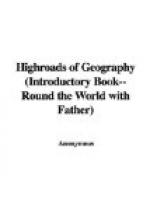4. Describe the picture on page 20 {Illustration entitled “Games on Board Father’s Ship"}.
Lesson 5.
1. The Nile carries much mud in its waters. If there is a stream near your school, go to it and get a bottleful of water. Let this water stand for a time and notice the mud which settles down. Where does this mud come from?
[Illustration: {Palm tree}]
2. Copy this little drawing of a palm tree. The Arabs say that the palm tree loves to have its foot in the water and its head in the fire. What do you think this saying means?
3. Look at the picture on page 23 {Illustration entitled “The Nile in Flood"}. What animals do you see in the picture? Tell me something about each of them.
Lesson 6.
[Illustration: {Two pyramids}]
1. Copy this little drawing of two of the oldest buildings in Egypt. Such buildings are called pyramids. Write out this word six times. You will see pyramids in the picture on page 23 {Illustration entitled “The Nile in Flood"}. Of what shape is the ground on which a pyramid stands? Make a ground plan of a pyramid.
2. How do we know what the men of Egypt were like in olden times?
3. The picture on page 25 {Illustration entitled “The Chief City of Egypt”} shows you a street in Cairo, the chief town of Egypt. Describe the picture.
Lesson 7.
1. Write out and learn: A long deep ditch filled with water is called a canal. Model a canal in clay or plasticine. What is the difference between a canal and a strait?
[Illustration: {Lighthouse}]
2. Copy this little drawing of a lighthouse. Write out and learn: A lighthouse is a tower near the sea. It shows a bright light at night to warn sailors of rocks or shallow places.
3. Why does a big ship “go slow” through the Suez Canal?
Lesson 8.
1. Write out and learn: A desert is a rainless tract of country on which little or nothing will grow. How can a desert be turned into a garden?
[Illustration: {Arab tent}]
2. Copy this little drawing of an Arab tent. Why do the Arabs who wander from place to place live in tents?
3. Write out and learn: A green spot in a desert is called an oasis. Several of these green spots are called oases.
Lesson 9.
1. The palm is said to have as many uses as there are days in the year. Name some of these uses.
2. Why is the camel called the “ship of the desert”?
3. Go to a sand heap. Stand on it; you sink in. Put a piece of board on the sand and stand on it; the board does not sink in much. Now turn to the picture on page 105 {Illustration entitled “Boys of Canada in Winter"}. You will see a pair of snow-shoes on the snow. A boy’s foot will sink into the snow. When he stands on the snow-shoes he does not sink in. Find out why. Notice the camel’s foot, and tell me why it does not sink into the sand.




